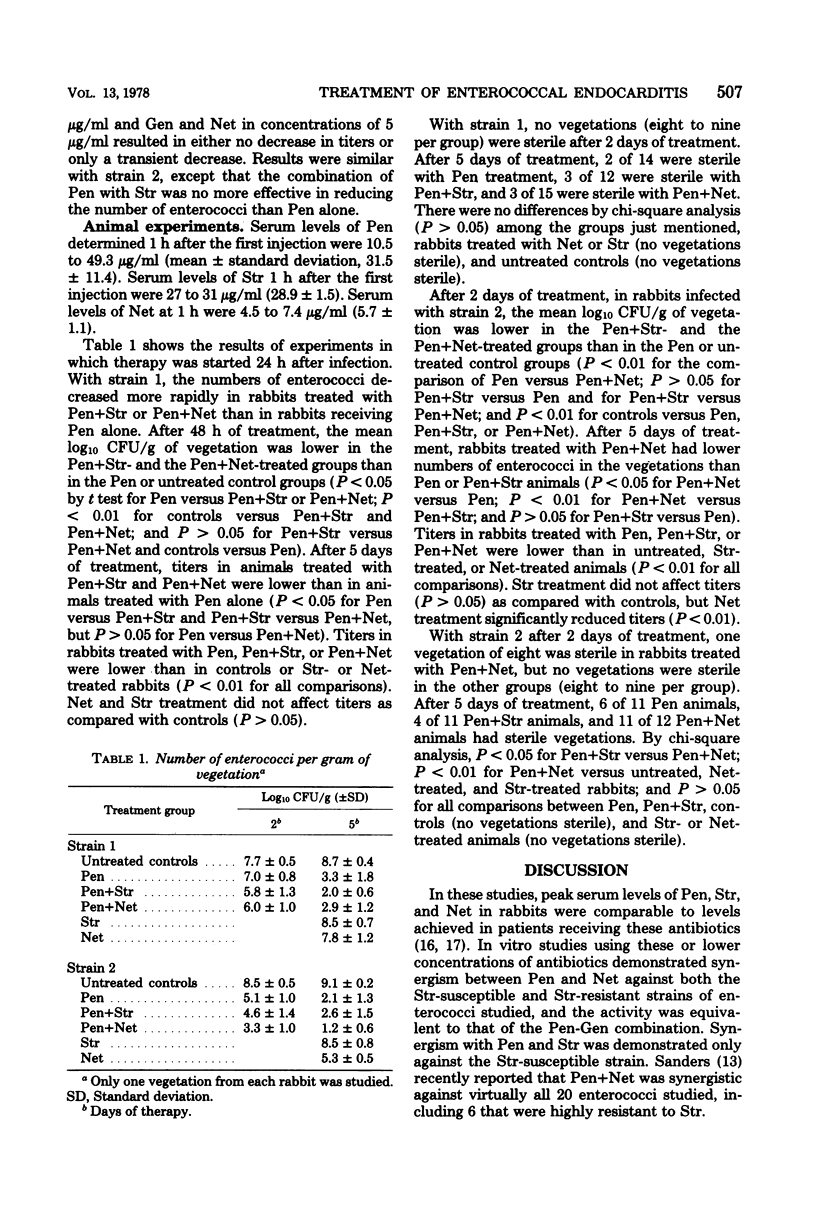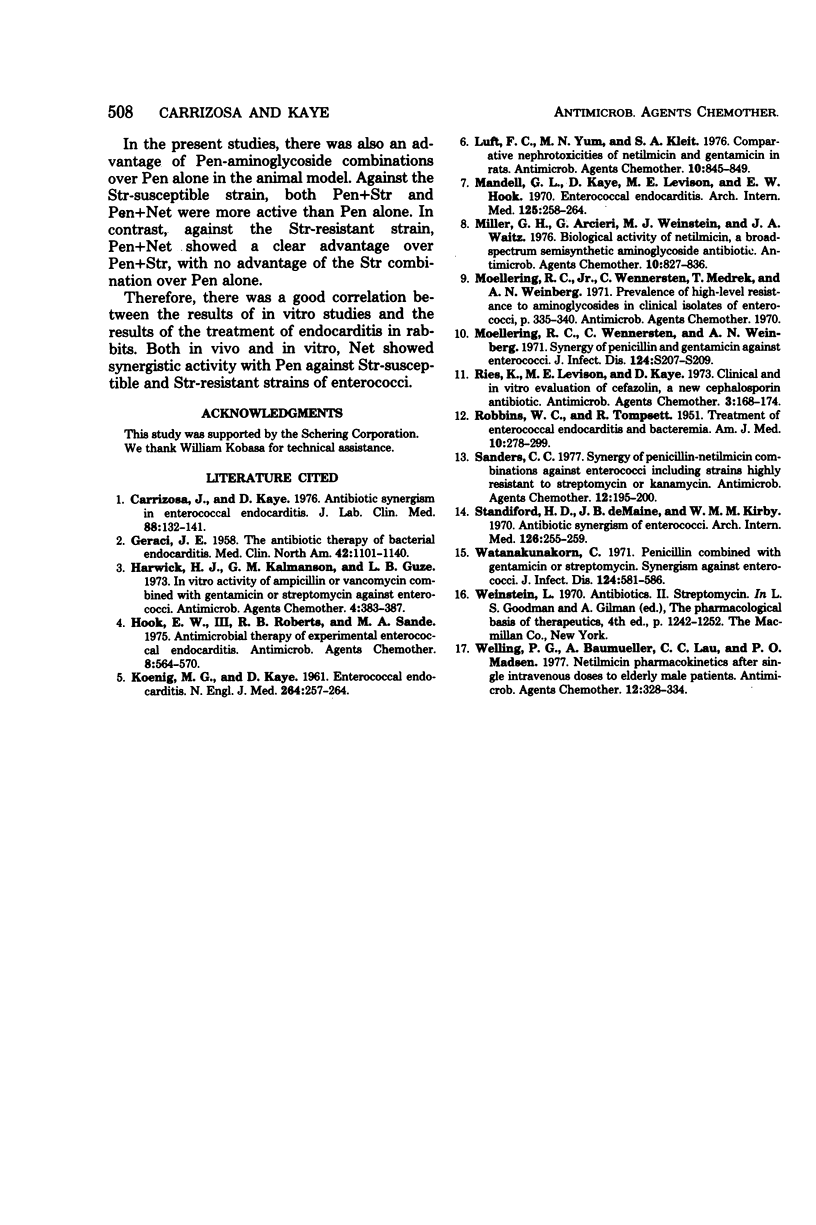Abstract
Successful therapy of enterococcal endocarditis requires the use of a combination of penicillin plus an aminoglycoside. The effectiveness of penicillin (Pen), streptomycin (Str), and netilmicin (Net), a new aminoglycoside, alone and in combination, were studied in vitro and in the treatment of left-sided enterococcal endocarditis in rabbits. In vitro Pen+Str or Net resulted in a more rapid and more complete bactericidal effect than Pen, Str, or Net alone against a Str-susceptible strain of enterococcus (strain 1). Against a highly Str-resistant strain (strain 2), Pen+Net showed an advantage over Pen, Str, or Net alone, or Pen+Str. Endocarditis was produced in rabbits with strain 1 or 2, and treatment was initiated 24 h later. Rabbits were treated for 48 h or 5 days with procaine Pen, Pen+Str, or Pen+Net. With strain 1, numbers of enterococci in the vegetations decreased more rapidly with Pen+Str or Pen+Net treatment than with Pen, Str, or Net alone. With strain 2, Pen+Net showed a clear advantage over Pen, Str, Net, or Pen+Str. Net in combination with Pen showed synergistic in vitro activity and was more effective than Pen alone in the treatment of enterococcal endocarditis in rabbits caused by both Str-susceptible and Str-resistant strains.
Full text
PDF



Selected References
These references are in PubMed. This may not be the complete list of references from this article.
- Carrizosa J., Kaye D. Antibiotic synergism in enterococcal endocarditis. J Lab Clin Med. 1976 Jul;88(1):132–141. [PubMed] [Google Scholar]
- GERACI J. E. The antibiotic therapy of bacterial endocarditis: therapeutic data on 172 patients seen from 1951 through 1957: additional observations on short-term therapy (two weeks) for penicillin-sensitivie streptococcal endocarditis. Med Clin North Am. 1958 Jul;42(4):1101–1140. doi: 10.1016/s0025-7125(16)34262-6. [DOI] [PubMed] [Google Scholar]
- Harwick H. J., Kalmanson G. M., Guze L. B. In vitro activity of ampicillin or vancomycin combined with gentamicin or streptomycin against enterococci. Antimicrob Agents Chemother. 1973 Oct;4(4):383–387. doi: 10.1128/aac.4.4.383. [DOI] [PMC free article] [PubMed] [Google Scholar]
- Hook E. W., 3rd, Roberts R. B., Sande M. A. Antimicrobial therapy of experimental enterococcal endocarditis. Antimicrob Agents Chemother. 1975 Nov;8(5):564–570. doi: 10.1128/aac.8.5.564. [DOI] [PMC free article] [PubMed] [Google Scholar]
- KOENIG M. G., KAYE D. Enterococcal endocarditis. Report of nineteen cases with long-term follow-up data. N Engl J Med. 1961 Feb 9;264:257–264. doi: 10.1056/NEJM196102092640601. [DOI] [PubMed] [Google Scholar]
- Luft F. C., Yum M. N., Kleit S. A. Comparative nephrotoxicities of netilmicin and gentamicin in rats. Antimicrob Agents Chemother. 1976 Nov;10(5):845–849. doi: 10.1128/aac.10.5.845. [DOI] [PMC free article] [PubMed] [Google Scholar]
- Mandell G. L., Kaye D., Levison M. E., Hook E. W. Enterococcal endocarditis. An analysis of 38 patients observed at the New York Hospital-Cornell Medical Center. Arch Intern Med. 1970 Feb;125(2):258–264. doi: 10.1001/archinte.125.2.258. [DOI] [PubMed] [Google Scholar]
- Miller G. H., Arcieri G., Weinstein M. J., Waitz J. A. Biological activity of netilmicin, a broad-spectrum semisynthetic aminoglycoside antibiotic. Antimicrob Agents Chemother. 1976 Nov;10(5):827–836. doi: 10.1128/aac.10.5.827. [DOI] [PMC free article] [PubMed] [Google Scholar]
- Moellering R. C., Jr, Wennersten C., Weinberg A. N. Synergy of penicillin and gentamicin against Enterococci. J Infect Dis. 1971 Dec;124 (Suppl):S207–S209. doi: 10.1093/infdis/124.supplement_1.s207. [DOI] [PubMed] [Google Scholar]
- ROBBINS W. C., TOMPSETT R. Treatment of enterococcal endocarditis and bacteremia; results of combined therapy with penicillin and streptomycin. Am J Med. 1951 Mar;10(3):278–299. doi: 10.1016/0002-9343(51)90273-2. [DOI] [PubMed] [Google Scholar]
- Ries K., Levison M. E., Kaye D. Clinical and in vitro evaluation of cefazolin, a new cephalosporin antibiotic. Antimicrob Agents Chemother. 1973 Feb;3(2):168–174. doi: 10.1128/aac.3.2.168. [DOI] [PMC free article] [PubMed] [Google Scholar]
- Sanders C. C. Synergy of penicillin-netilmicin combinations against enterococci including strains highly resistant to streptomycin or kanamycin. Antimicrob Agents Chemother. 1977 Aug;12(2):195–200. doi: 10.1128/aac.12.2.195. [DOI] [PMC free article] [PubMed] [Google Scholar]
- Standiford H. D., De Maine J. B., Kirby W. M. Antibiotic synergism of enterococci. Relation to inhibitory concentrations. Arch Intern Med. 1970 Aug;126(2):255–259. [PubMed] [Google Scholar]
- Watanakunakorn C. Penicillin combined with gentamicin or streptomycin: synergism against enterococci. J Infect Dis. 1971 Dec;124(6):581–586. doi: 10.1093/infdis/124.6.581. [DOI] [PubMed] [Google Scholar]
- Welling P. G., Baumueller A., Lau C. C., Madsen P. O. Netilmicin pharmacokinetics after single intravenous doses to elderly male patients. Antimicrob Agents Chemother. 1977 Sep;12(3):328–334. doi: 10.1128/aac.12.3.328. [DOI] [PMC free article] [PubMed] [Google Scholar]


